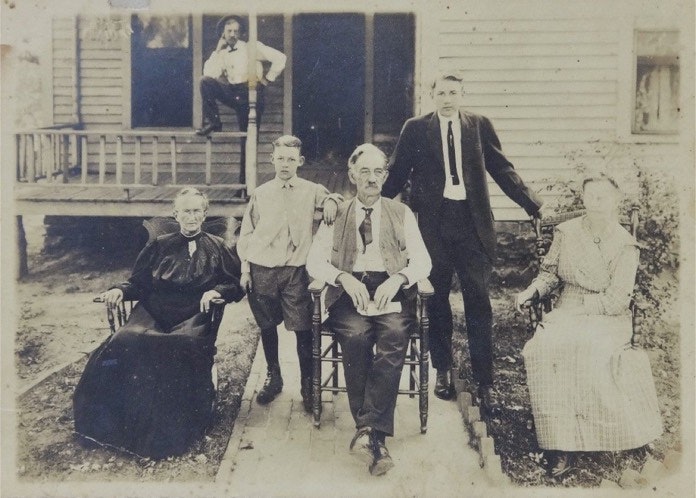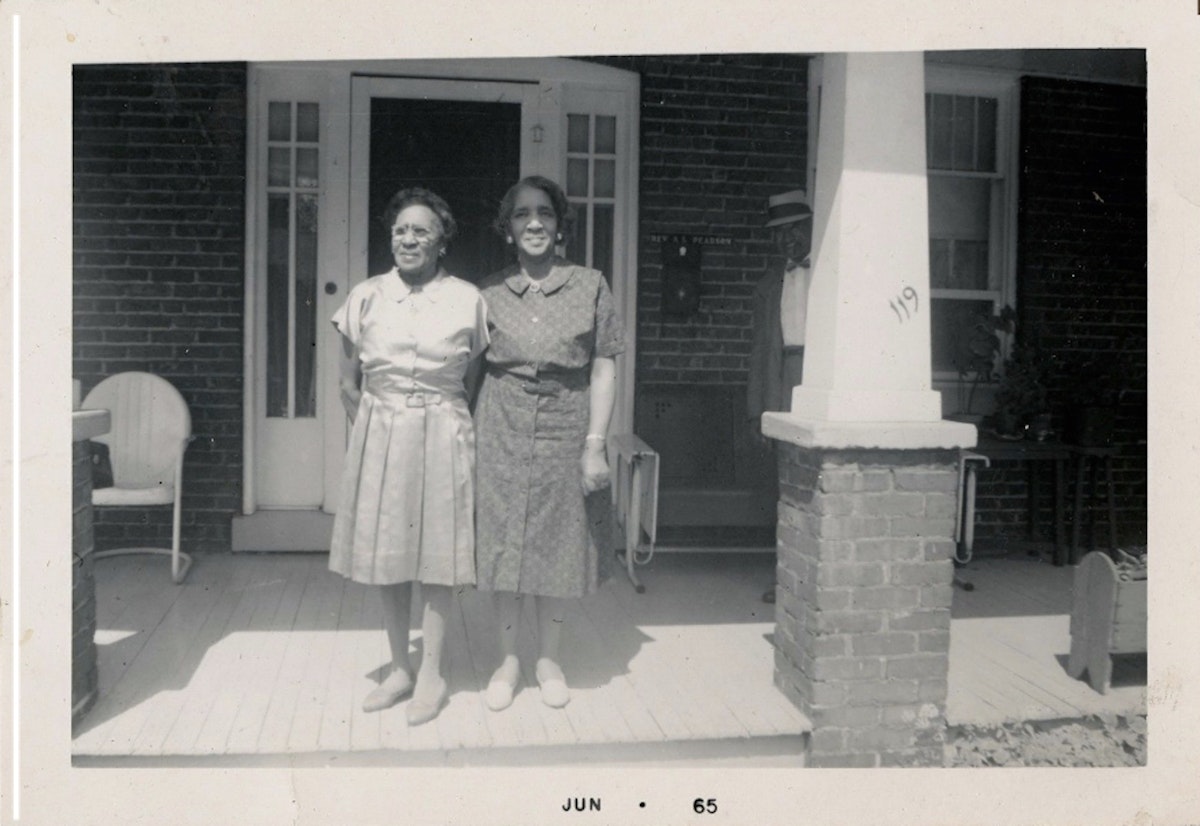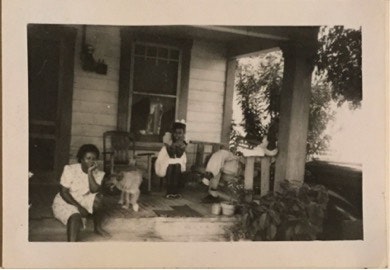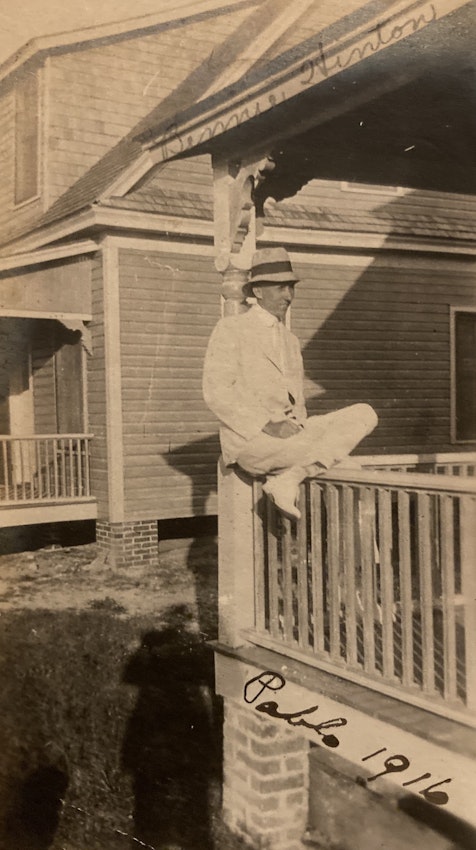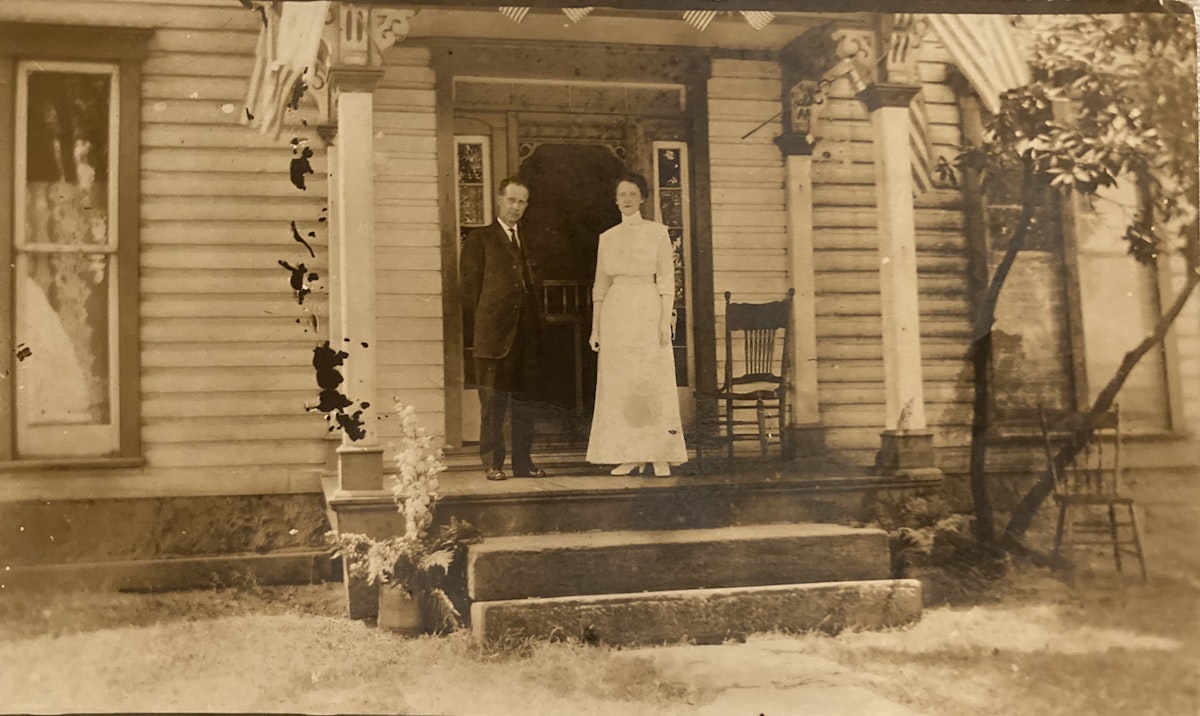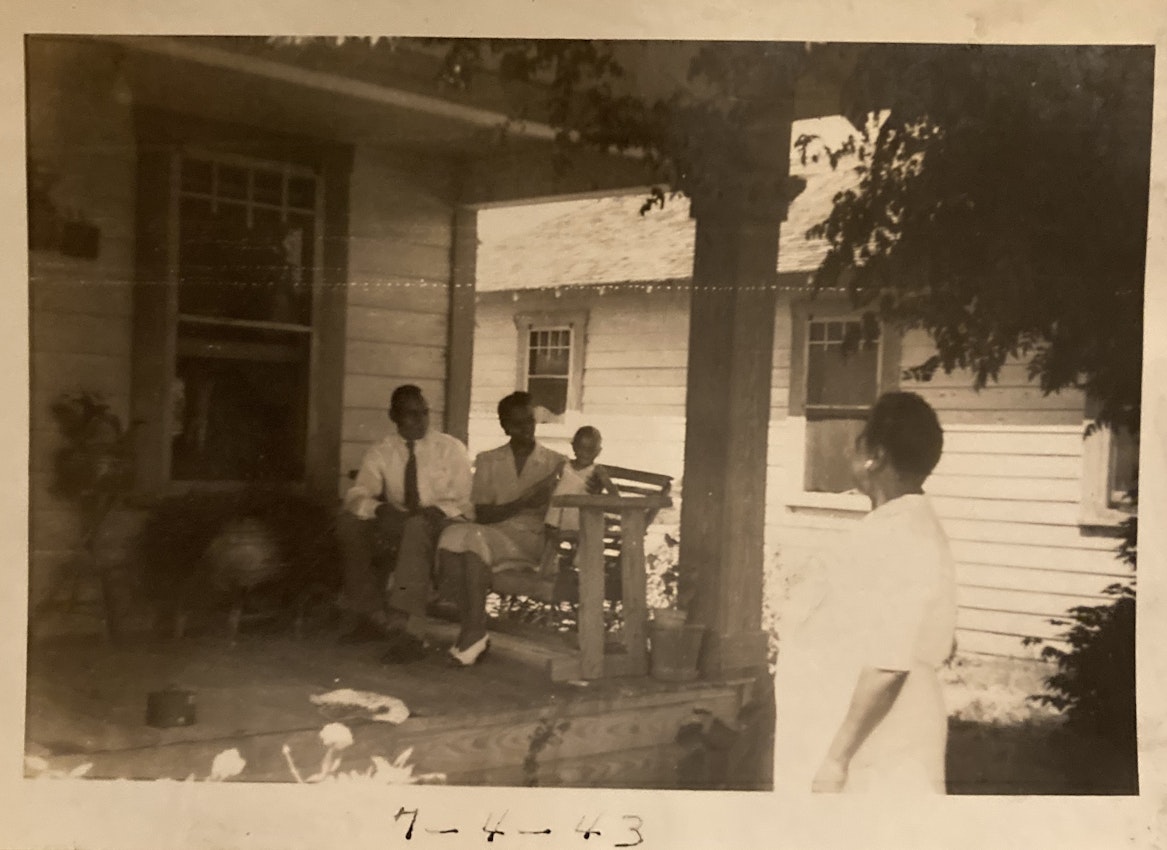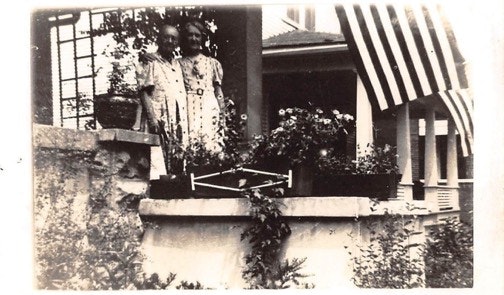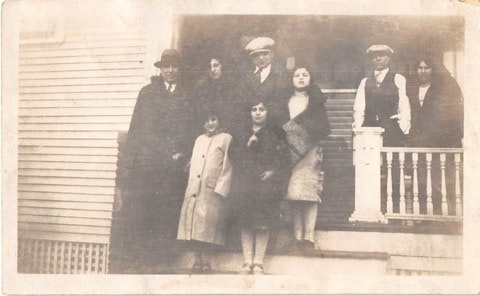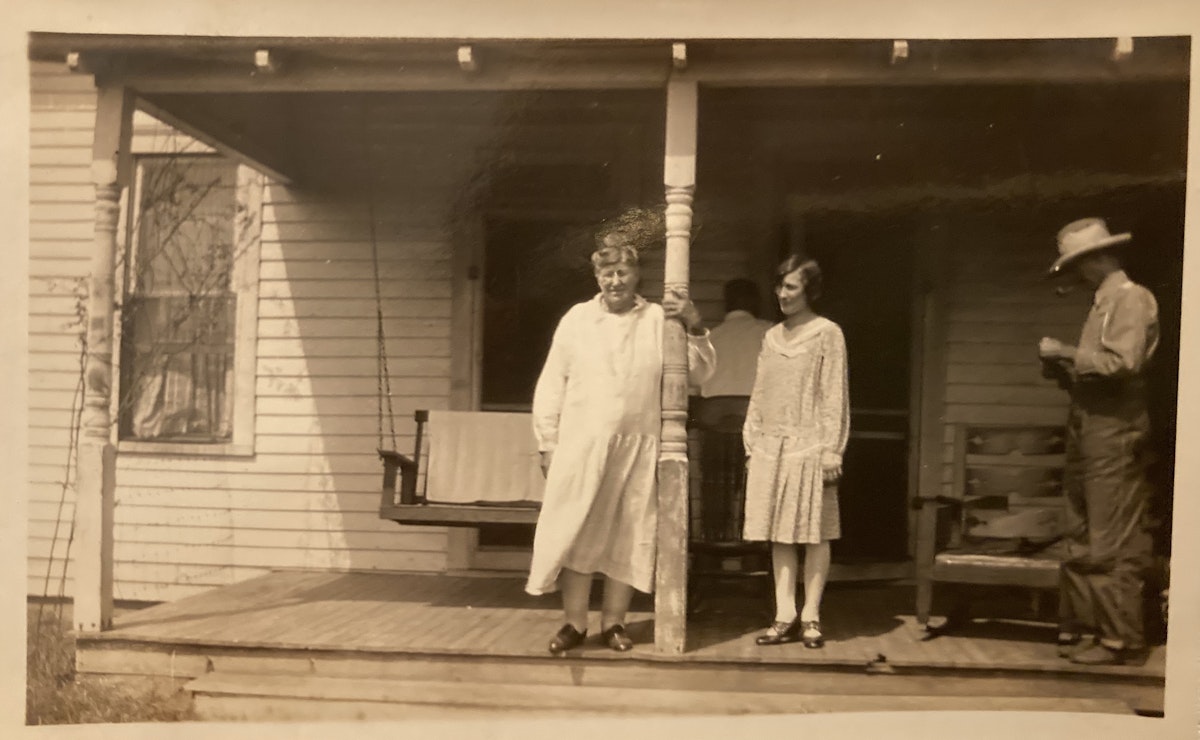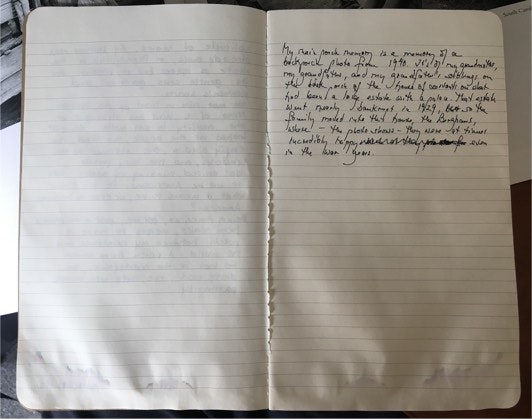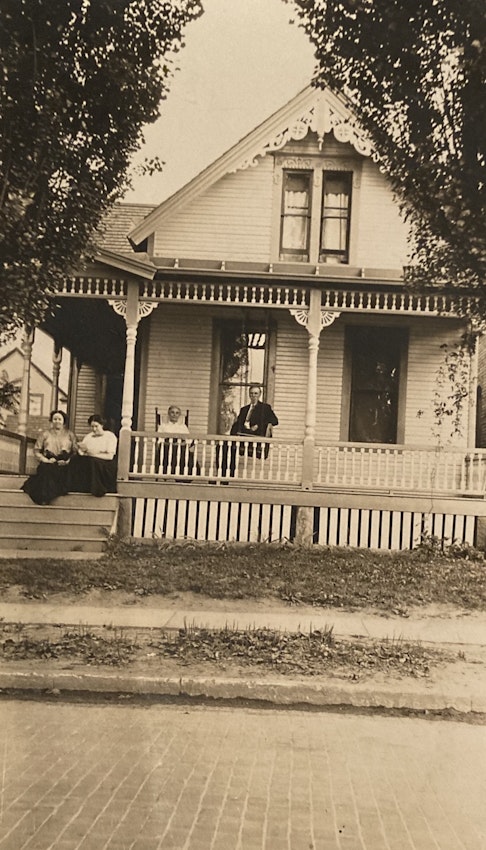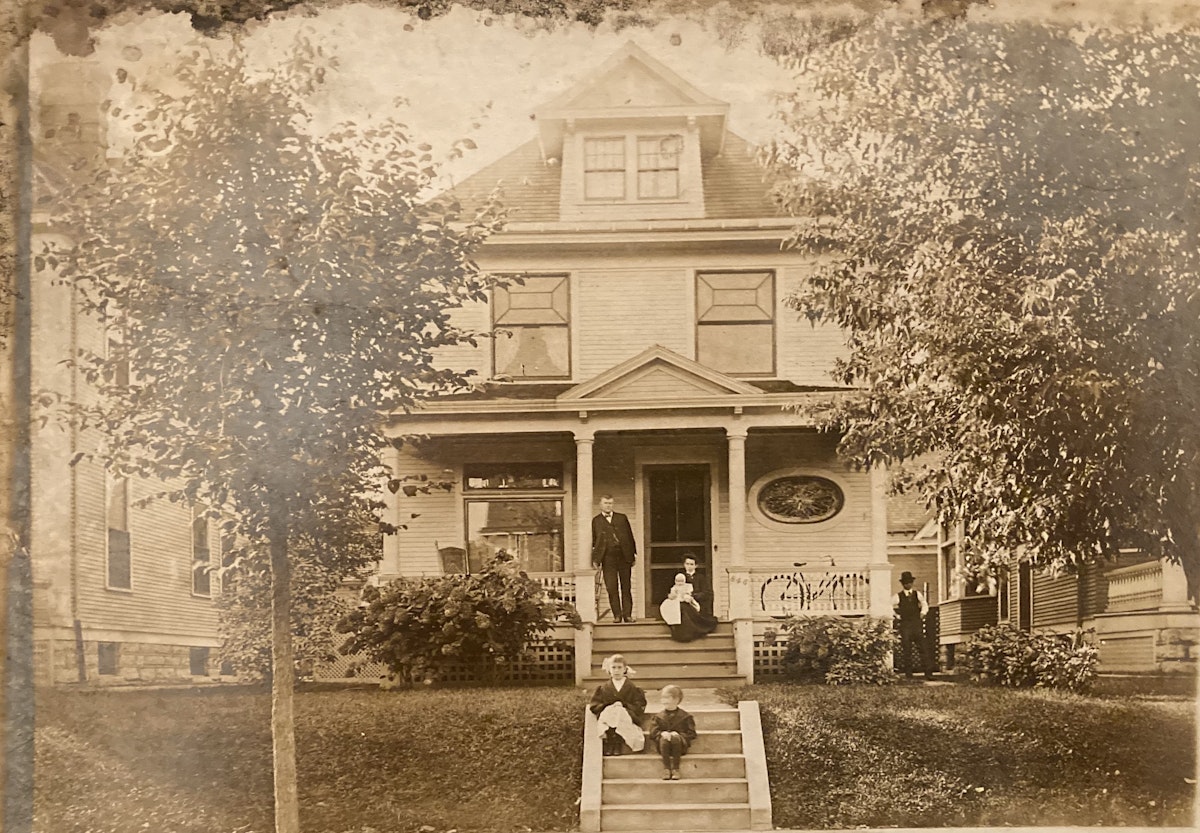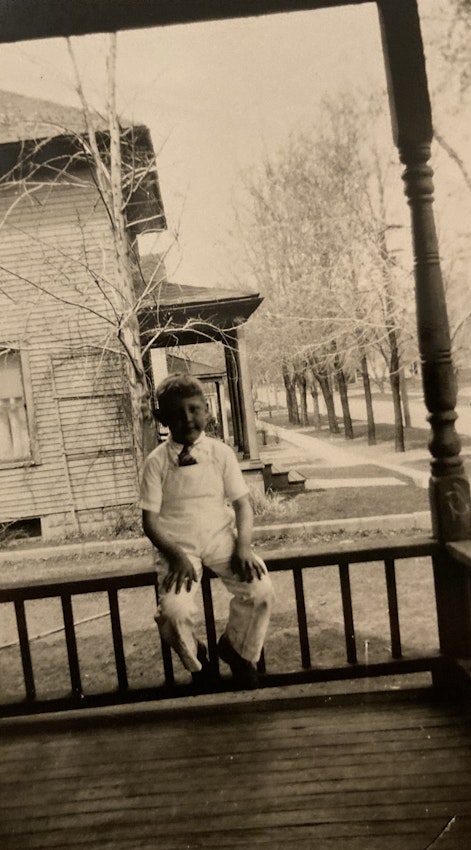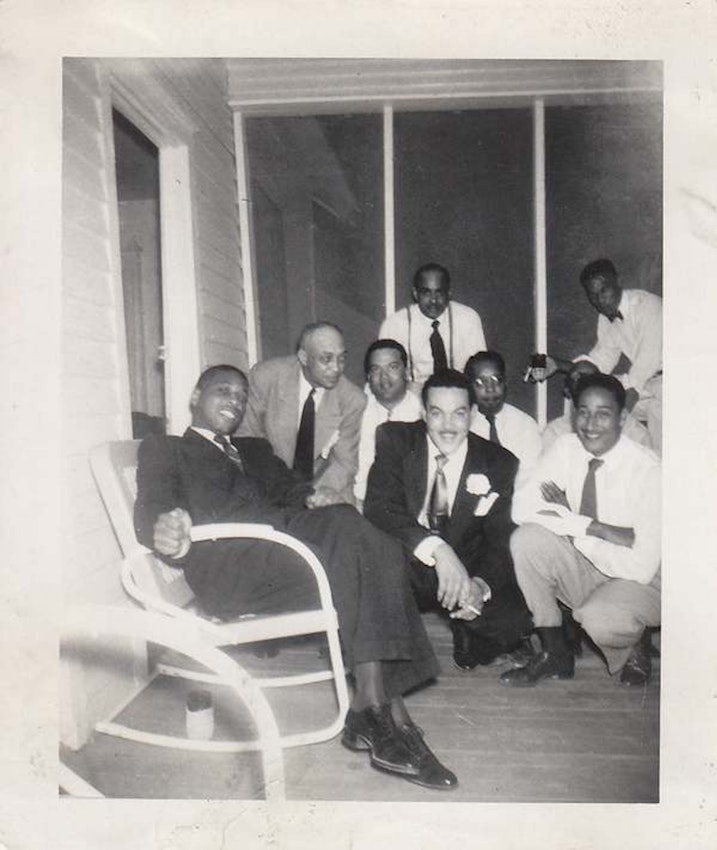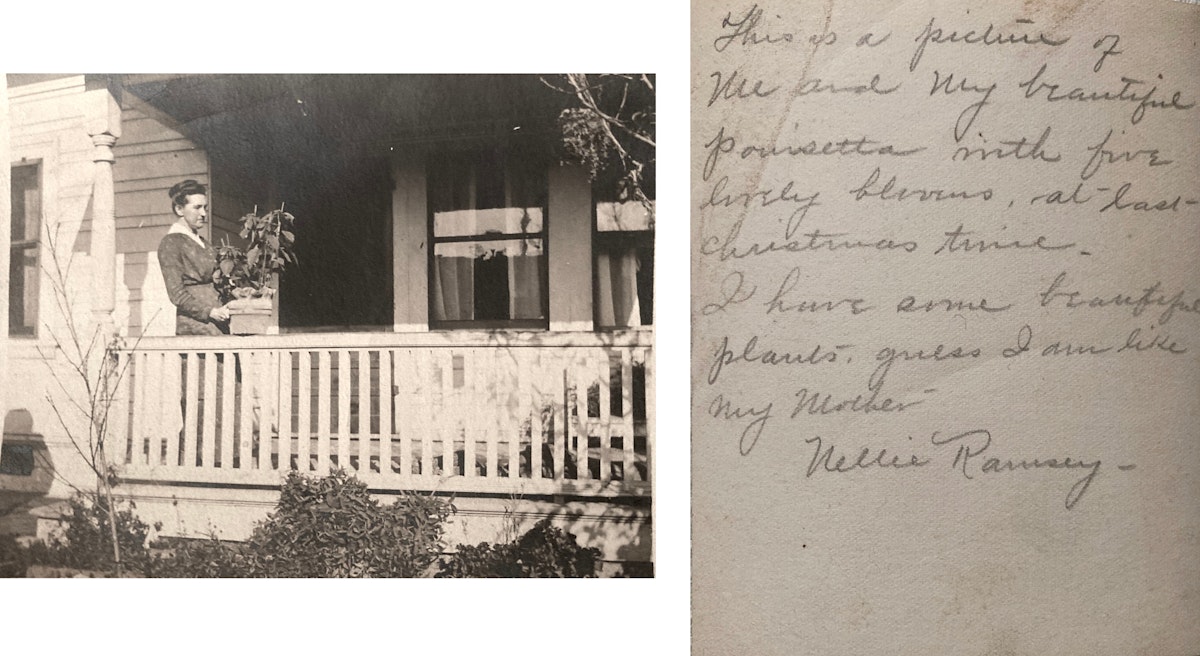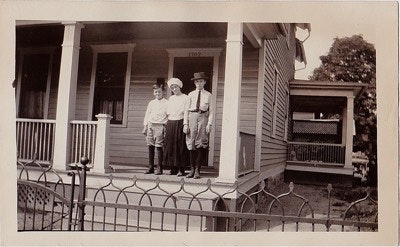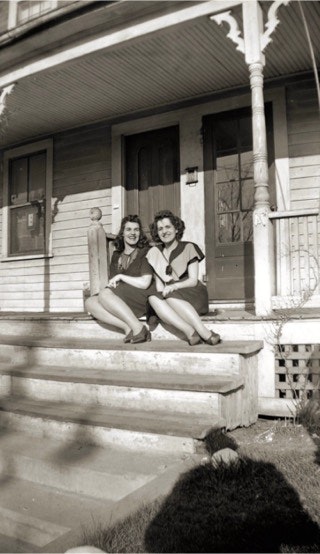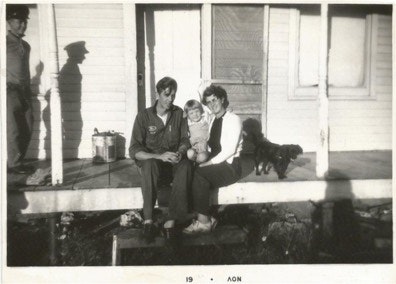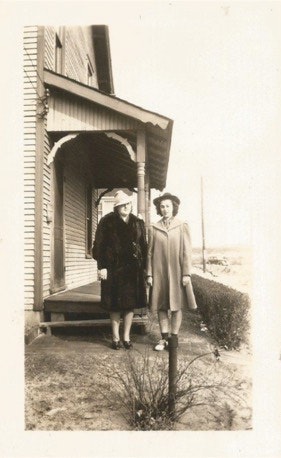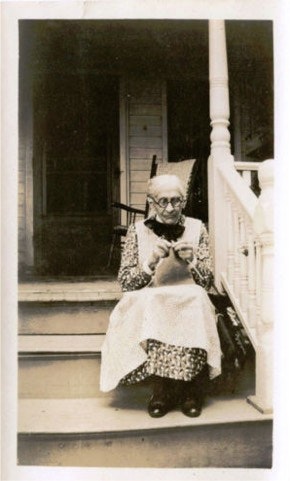Porch Memories
In the final stanza of his remarkable poem “Sunday Morning” (1923), Wallace Stevens refers to Jerusalem (and more specifically the tomb of Christ) as, possibly, “the porch of spirits lingering”. It is such a strange formula that it has endured: the “porch of spirits”, the place where they “linger” — this is any portal or threshold linking (and also separating) human beings from whatever gods or angels there might be. A lovely notion. But why did Stevens choose that homely word, and that most quotidian of sites: the porch? A “portico” (whence the word derives) is something grand. But a “porch”? It is the postage-stamp façade of a temple (or is it a tomb?) pasted in miniature upon our domestic architecture. In a secular age, as Stevens understood so well, this is where our spirits, whatever they may be, are left to linger. Federica Soletta sits with them awhile in the affecting photo-essay that follows. — D. Graham Burnett, Series Editor
PUBLISHED
August 4, 2021
One day, in a thrift store in Brooklyn, I found a box full of old family photographs. I felt immediately the reality of the people depicted, and with that sense came many questions, along with a churning curiosity about their lives and deaths. Old photographs often work that way. But here there was something else, too. Something that caught my attention — something perhaps unremarkable to an American eye but certainly unusual to a foreigner like me. My punctum, in these images, had the shape of a rigid frame, a structural element present in many of the photographs, although never as the main actor: the American porch.
Typically made of wood and partially surrounding the house, the porch is a boundary between the outside world and the intimacy of a home’s interior, seen and lived as both a private and an open space. In the U.S., the porch is an adaptation, a point of convergence of different architectural traditions: an adjustment to the many European revivals of the nineteenth century and an assimilation of Haitian house styles, imported by free Black people in the South, probably coming from West Africa. Perhaps, even a liminal zone between civilization (the house itself) and the wild (the outer world). In these terms, the porch is a kind of frontier. In America, it becomes a transverse element — seen across Victorian mansions, landowner houses, and low-income habitations — and spans geographies as well: while always more predominant in the South, porches, in many forms, achieved wide popularity in the whole of the United States.
Even more ubiquitous than the porch in America are American porch photographs. Since the end of the nineteenth century, the American porch became a privileged background for family portraits. Is it possible to speak of a “photographic tradition”? And if so, how did this “photographic tradition” evolve? What kind of history, and how many stories, do these photographs narrate? What kind of archive have they produced? What do they suggest to us about photography, about family photographs, and, most explicitly, about American history and families?
The people in most family photographs pose, play, or smile, and are usually aware of the photograph being taken. While the families are different, the formal similarities are many: the group arrangements, the closeness of the subjects, likenesses across the components of the group, or their generational gaps. In the photographs that follow, the construction of the visual space, too, becomes a common element. It is a backdrop or setting for the protagonists, who stand in front of (or just outside) the entrance door of their house. Although they are not inside, they still feel “at home” in a space of transition and safety: on the porch or just close by it.
Photo-historian Geoffrey Batchen reminds us that snapshots are an art historian’s worst nightmare, for they resist “value judgments”, which is, of course, “a key element of traditional art historical practice”.1 Agreeing with him, my intention is not to invent an art history of “the porch photograph”, for these photographs do not belong to the world of art history. Nor do I aim to search for the people portrayed in the photographs, or to elucidate what specific action is depicted in each image. Instead, here I will treat these photographs as objects of and for history, a history in the lower case. “All photographs”, John Berger once wrote, “are contributions to history, and any photograph, under certain circumstances, can be used in order to break the monopoly which history today has over time”.2 In weaving fictitious and real memories, personal and quoted reflections, these notes attempt to “ventriloquize” the images and to listen to them, without a storyline or individual captions. Banal, yet tender, this set of photographs does not only portray the daily gestures of life on the porch and the functionality of this distinctive space. These images can also be used as a lens by which to reveal other scenes and stories. Or possibly for looking differently — with a different gaze — at our own history: either the old history of a nation or a new history of photography. My thoughts will serve as suggestive threads, but to you, reader, is left the final interpretation.
We always belonged to this porch. The trip was long, the heat sometimes unbearable, the train very slow, very crowded, very noisy. But certainly there was the sky. Nowhere in Wales did we have this kind of sky: grand, vast, at times even frightening in its curve and reach. In Wales, we may have beautiful grey clouds and green valleys as you cannot even imagine, and the magic torpidity of foggy mornings. But a sky like this won’t fit in Wales. It was, we thought, enough to look at the sky to hope for the future. The future was everything we had. You don’t take a trip like this if you don’t have some future to bring with you, tightly packed in your luggage. We had just a few things with us, mostly distant memories and dirty clothes. My wife with a child inside her, a baby that would be an American, the first of us. We didn’t need much more. We were an ordinary story at that time. Pennsylvania seemed like a very exotic name for us, a name that meant a house, some land, and silent nights on an American porch to remember the solitude of Wales. My brother was already there, in Pennsylvania. He wrote us letters full of passion for its polite cows, simple food, and women’s hearts. We met him in front of his house. None of us had the strength or the ability to say much. We just looked at the house, the empty garden, the curtains on the windows, and the airy porch. We arrived thinking of Wales. Now we will be Americans. Do you know what it means to be, or even to become, American? Being American, for me, a shepherd coming from Wales, means to have a porch between my existence and the world. A porch from which to look at the countryside, the dusty road, the infinite sky, the carts with horses passing by.
So here’s a book of photographs about America. It’s not the first, perhaps not even the best book of pictures of us, but it’s an eloquent one, one of the most fluent I have come across and enjoyed. The pictures are for the most part mild, but in spite of this, though always exquisitely clear in reasoning and in visual quality, they pack a wicked punch. There’s nothing oppressively “photographic” here, it isn’t a long nose poking into dirty corners for propaganda and for scandal, there are no trick shots, the composition isn’t a particular feature — but the pictures talk to us. And they say plenty.3
Williams points to photography’s relation with the visible and the invisible. In order to speak to us, photographs may conceal their “photographability”, perhaps even their purpose or beauty. In this way, he also seems to suggest that a photograph, or a series of photographs, has the ability to reveal America’s deep essence. As if within the photographs, one could possibly find a visual common denominator for America, an American iconography.
But the pictures whisper to us. And they say plenty. When “listening” to these photographs and reading them in relation to each other (despite the differences of era, geography, and economic status of the families), one may uncover a double identity. The first represents the intimacy of a house: the secret relations within a family and its singularity. The other illustrates a much larger story: the common history of a country. As a family album, one by one, they uncover and delineate the American life and its identity.
In this way, the familial gaze becomes itself a kind of lens, an involuntary panoramic zoom turned to a national self and a national gaze. If there is something familiar in every family photograph, something that reminds each of us of our own family, it is perhaps because each photograph appears to follow a similar visual script that makes itself visible through the image’s composition and intention — unique yet universal. But in the case of the “porch photographs”, there is something more: the elements of remembrance, mourning, life and death that are typical of every photograph, especially of family portraits, intertwine with the representation of an architectural object. And it is through these images that the porch became a symbol, an integral part of “Americanness”, even a metaphor of America, with its community and its contradictions.
In Porch Portraits, photographer Susan Meiselas offers a fragmentary documentation of domestic life in the countryside of South Carolina and Mississippi. The series is not just a collection of photographs on or of porches, despite the title of the project. Sometimes the porch is visible, although not as the main subject; sometimes it is not even present. Sometimes it is the place of exchange between the gaze of the photographer and that of the people portrayed; other times it is just another type of frame, a visual reference. Yet, Meiselas’ title, “Porch Portraits”, immediately reminds us of the setting that we will see in the photographs. The porch does not simply divide the interior life from the outdoor one. Nor does it merely separate the private, individual space from the wild American landscape, another leitmotif of the American identity. As in Meiselas’ photographs, the porch also belongs to the life of the American house, to its memory.
It is in these terms that one may think (as I do) of the porch as the epitome of a certain American life, not simply as an architectural landmark but as a domestic — and photographic — lieu par excellence, as described in books and shown in movies. Perhaps, we can even think of the porch as a space of empathy: it is on the liminal porch that, in To Kill a Mockingbird, Scout realizes what it means to be in someone else’s skin, to see from another perspective:
The immobile porch and the moving flags. From the outside, the porch can be thought of as a three-dimensional billboard, since it is where the American flag can be displayed — an advertisement, a testimony of belonging. But what if you don’t belong to the porch or to the flag? Here is the vulnerability of the space, that strangeness that the photograph cannot stop echoing. The porch becomes an eye-level flagpole, whether the flag flies or not. This is an ensign by which to veil or reveal America.
The porch is an all-encompassing cinematic screen: projected on it are the smiles of immigrants, the suburban growth of the 1950s, social and racial inequalities, economic booms and crashes. In the photograph, the porch is a space of encounter and possession, it belongs to the viewer as much as to the users. Rooted in its location, the porch echoes a sense of belonging, while also being in constant transformation (and, in a way, remaining the most vulnerable part of the house). If the American porch mirrored the evolution of an entire country and of its landscape, fashions, and migrations, it is also a sign of the violence and appropriation of its territory. The porch photographs — spontaneous and involuntary historical witnesses — bring fragments of America’s past into its present and future: they bear the traces of multiple stories that will become the official American history.
Yet the porch photographs distance themselves from the historical documentation of, for instance, Walker Evans or Dorothea Lange in their work with the Farm Security Administration during the late 1920s and 1930s. The familiar atmosphere that is visible in the porch photographs reveals an innocence of intention. The porch was indeed a successful place where everyday life was experienced, photographed, and passed by. Evans’ and Lange’s documents are meant to keep the eye of the camera focused on a specific object of study with an underlying tension. They remind us of an ethnographic gaze, with the exactitude of the photographer’s external eyes. The family photograph, instead, has the family itself as both subject and object. Every kind of happening is recorded there: the evidence of laughter, a memorable Christmas day wearing a nice dress, the old lady knitting, the happiness of a child with a toy, or a couple or friends posing in front of the camera.
There is a clear consciousness of the camera in these images, an exceptional performance that is able to register, once and for all, the repetition of everyday gestures. And in this arises a legible conflict: the planned pose against the pure spontaneity of the moment. The porch is more than the stage of this conflict. It is, in a sense, an involuntary testimony to the antinomy: it is itself, in its physicality, a frame for presentation; it is also the promise of everyday safety and intimacy.
My main porch memory is a memory of a back porch photograph from circa 1940. It is a picture of my grandmother, my grandfather, and my grandfather’s siblings on the back porch of the servants’ house in what had been a large estate with a palace. That estate went nearly bankrupt in 1929, so the family moved into this house, the Barghans, where, on the porch, the photo shows they were at times incredibly happy even in the war years.
Several years ago, I showed a series from my porch photograph collection in a small exhibition, and I asked the public to interact with the collection by writing, in an adjacent notebook, a personal memory or experience related to the porch. My intention was to gain insight into the relationship that the public (mostly American) had with the life on the porch and its “photographability”. Whether one of the photographs triggered the memory above, or the writer had already a memory of this particular porch in her mind, I cannot know. Yet, it struck me to read that her memory was not about a specific moment, action, person on a porch, or even of the space itself, but rather about another photograph. It was a moment she has not lived, except, of course, through the image. Her words suggest a tenderness about the house, and most specifically about the porch, that is revealed and internalized through the medium of the photograph — so much as to become a memory of “it”.
Her description belongs to all photographs, as it manifests the power of each and every photograph to bear the traces of memory. There is a uniqueness, however, in her note and in the image she recalls — the uniqueness of the specific moment in which her grandparents were happy on “the back porch”. Even with her brief description, we can almost imagine and visualize “her photograph” and feel it as our own. In the same way, every porch photograph becomes her porch memory.
The porch and the photograph (I’ll treat them as near-synonyms at this point) do not permit us to see the inside of the house or the privacy of its interiors. We can only imagine the grandiosity or humility of the interior spaces and the richness or frugality of the back yard. If the porch becomes a screen, the photograph acts as a further medium. With its frame and porosity, it sets a different network of spatial and physical relations. The cropped photographic image transforms the rhythm of the space and the visual understanding of the porch. Through this rhythm and the dialog between the frame of the camera and that of the porch, one may write a further history of photography.
Carefully conceived is the composition: the family is staged on the porch. The porch is a special place, and the photograph is a special moment, a planned action, a mise en scène for the memory of the family. “Being portrayed” was not an everyday thing at the end of the eighteenth or start of the nineteenth century. Following the rule of the studio, we can imagine the photographer en plein air setting and composing the scene, while the family is tidying up the porch. The distance of the mechanical eye is understandable, as early technology needed more light and a wider field. Perhaps, however, the singular faces of the family were not the main focus of the photograph: being photographed on the porch, as a family, also meant to show one’s own fortune and physical possessions.
In the small frame of the photograph, the spatial distance between the viewer and the subject has a visible consequence, since including the house meant blurring the facial features of those who patiently stood and posed on the porch. The porch, the family, and the house harmoniously became one entity. The possession of one’s own house (the American dream) intertwines with the sociological implication of photography and the act of being photographed. If the house with the porch is a status symbol, being photographed on the porch is not merely a memory but also a most powerful act of ownership and belonging.
Moving forward in time, the composition becomes less formal and more familiar. The use of the camera is cheaper, more popular, and easier to manage. The porch changes status, turning into a mere platform (rather than a proper back-ground) on which life is performed and recorded. As a result, the camera steps onto the porch and deconstructs it. Only fractions are visible: a column, the steps, a portion of the roof. The porch is almost transparent; we perceive its presence without seeing it. Later, in the second half of the twentieth century, the privileged space of the home’s photographer changes to the new gathering point of the family: the television room. Another medium, another gaze on the world.4
Just a little behind us on our left and close on the road was a house, the first we had passed in several miles, and we decided to ask directions of the people on the porch, whom, in the car mirror, I could see still watching us. . . . There were three on the porch, watching me, and they must not have spoken twice in an hour while they watched beyond the rarely traveled road the changes of daylight along the recessions of the woods, and while, in the short field that sank behind their house, their two crops died silently in the sun: a young man, a young woman, and an older man; and the two younger, their chins drawn inward and their heads tall against the grained wall of the house, watched me steadily and sternly as if from beneath the brows of helmets, in the candor of young warriors or of children.— James Agee and Walker Evans5
Evans is looking at the people on the porch; their eyes are responding silently. The photograph transforms the individual act of looking into an infinite, circular correspondence of gazes. As a theatrical stage, the porch is a place from which you look at the world, while the world looks back at you. Porch photographs make such reflections of regard endless, as the viewer not only steps into the shadow of the photographer, but also becomes the new audience. One may imagine that there’s no better podium on which to be seen and remembered than the American porch.
Running and hiding in the shadow of the columns — this is my porch memory. I cannot recollect a specific day, season, or place for any of them, because my porches belong to another geography, where most of the “portici” surround a piazza and are, therefore, a properly public space. There was nothing I could “possess”. I have as many porch memories as there were piazzas through which I ran, or over which my eye passed.
My grandfather was born in Duluth in 1904, the second son of an Italian immigrant couple. While working in New York, in his 20s, he went back to Italy to visit some relatives. There he met my grandmother and never went back to New York or Duluth. He built a new house for his new family, a house for his Italian daughters — daughters who would not be Americans, my mother and her two sisters. The house was a medium-sized one, almost anonymous in a small village in the very north of the country, close to the Alps, close to Switzerland. It is a normal, medium-sized house of a Lombardy province, in a row of normal, similar houses, facing what was a quiet village road. Shades of ochre and rose, with ordered trees planted on the edge of the curbside. It was a tranquil house, two stories, with a steep roof, a garden all around, and a balcony.


